| Peruvian Navy |
|---|
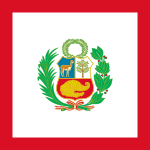 |
| History |
| Ships |
| Insignia |
| Organisation |
This is a list of major battles fought by the Peruvian Navy since its creation in 1821.
| Peruvian Navy |
|---|
 |
| History |
| Ships |
| Insignia |
| Organisation |
This is a list of major battles fought by the Peruvian Navy since its creation in 1821.
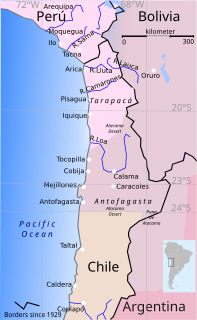
The War of the Pacific, also known as the Saltpeter War and by multiple other names, was a war between Chile and a Bolivian–Peruvian alliance from 1879 to 1884. Fought over Chilean claims on coastal Bolivian territory in the Atacama Desert, the war ended with a Chilean victory, which gained for the country a significant amount of resource-rich territory from Peru and Bolivia.

The Battle of Angamos was a naval encounter of the War of the Pacific fought between the navies of Chile and Perú at Punta Angamos, on 8 October 1879. The battle was the culminating point of a naval campaign that lasted about five months in which the Chilean Navy had the sole mission of eliminating its Peruvian counterpart. In the struggle, two armored frigates, led by Commodore Galvarino Riveros Cárdenas and Navy Captain Juan José Latorre battered and later captured the Peruvian monitor Huáscar, under Rear Admiral Miguel Grau Seminario.

Mariano Ignacio Prado Ochoa was a Peruvian army general who served as the 16th and 21st President of Peru.

The Chincha Islands War, also known as Spanish–South American War, was a series of coastal and naval battles between Spain and its former colonies of Peru, Chile, Ecuador, and Bolivia from 1865 to 1879. The conflict began with Spain's seizure of the guano-rich Chincha Islands in one of a series of attempts by Spain, under Isabella II, to reassert its influence over its former South American colonies. The war saw the use of ironclads, including the Spanish ship Numancia, the first ironclad to circumnavigate the world.

The Battle of Punta Gruesa was a naval action that took place on May 21, 1879, during the War of the Pacific between Chile and Peru. This may be labelled as the second part of the Naval Battle of Iquique, although it is described in many sources as a separate battle.

The Gran Colombia–Peru War of 1828 and 1829 was the first international conflict fought by the Republic of Peru, which had gained its independence from Spain in 1821, and Gran Colombia, that existed between 1819 and 1830.
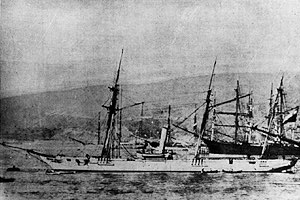
The schooner Virgen de Covadonga was a ship that participated in the Chincha Islands War and the War of the Pacific, under Spanish and Chilean flags. She was launched in 1859. Covadonga hit a floating mine and sank off Chancay in 1880.

Juan Guillermo Moore Ruiz was a British Peruvian navy officer. He was killed during the Battle of Arica.
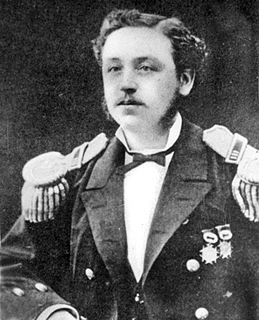
Carlos Arnaldo Condell De La Haza was a Chilean naval officer and hero of the Battle of Punta Gruesa during the start of the War of the Pacific.

The Naval campaign of the War of the Pacific or Saltpeter war, was a naval campaign that took place from 1879 to 1884, involving Peru, and Chile, undertaken in order to support land forces in the Atacama Desert. Although the conflict lasted until 1884, the primary naval engagements occurred between 1879 and 1880. Due to the rough terrain and few transport methods it was imperative to have control of the ports in order to have a good supply source in the region. It resulted in a successful campaign by Chile, and the success of their land campaigns eventually led to a Chilean victory, which cut off Bolivia's access to the coast.
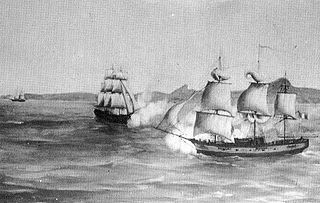
The Battle of Punta Malpelo was a naval encounter between a Peruvian corvette and two Gran Colombian vessels on 31 August 1828, near the port of Guayaquil, and was the first major combat of the Peruvian Navy as an independent force of the newborn Peruvian nation.

Leoncio Prado Gutiérrez, was a Peruvian soldier and adventurer who participated in various military actions against Spain; in Cuba and the Philippines in the 1870s. He also participated in other wars such as the Chincha Islands War (1865-1866) and the War of the Pacific (1879-1883), dying in the latter.

The Battle of Iquique was a naval engagement that occurred between a Chilean corvette under the command of Arturo Prat Chacón and a Peruvian ironclad under Miguel Grau Seminario on 21 May 1879, during the naval stage of the War of the Pacific, that pitted Chile against Peru and Bolivia. The battle took place off the then-Peruvian port of Iquique. The ironclad Huáscar sank the Chilean wooden corvette Esmeralda, after four hours of combat, resulting in a Peruvian victory.

Rímac was a steamer involved in decisive actions of the War of the Pacific (1879–1884) and Thousand Days' War (1899–1902).
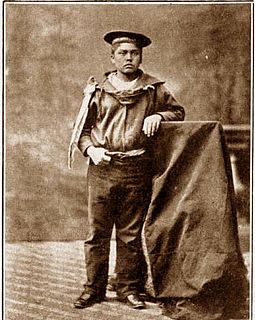
Juan Bravo was a Chilean Navy sailor of mapuche origin, hero of the naval Battle of Punta Gruesa during the War of the Pacific. Juan Bravo distinguished himself in the Battle of Punta Gruesa where he while onboard of the schooner Covadonga sniped down numerous Peruvians on board of the ironclad Independencia.

BAP Unión was a corvette of the Peruvian Navy, originally ordered by the government of the Confederate States of America during the American Civil War. Built in France it was bought by the Peruvian Navy and during its service participated in the Chincha Islands War and in the War of the Pacific in which it was scuttled following the Blockade of Callao to prevent it falling into Chilean hands.
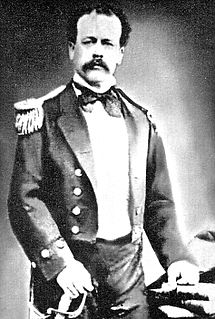
Aurelio García y García was a Peruvian marine, diplomat and politician. He was friend and comrade in arms of Miguel Grau, Manuel Ferreyros and Lizardo Montero, all of them made up a remarkable generation of Peruvian sailors known as the Four Aces of the Peruvian Navy. He was also elected Mayor of Lima in 1877. He was also a man of wide culture, who was fully fluent in the English language and who had scientific inclinations.

Nicolás Federico Portal was a Peruvian captain and politician during the War of the Pacific. He is known for being the captain of the BAP Unión throughout the war.

The battle of Cruces was a naval confrontation between the Peruvian and the Gran Colombian navy which occurred from 22 to 24 November 1828. The following blockade of the port of Guayaquil by the Peruvian Navy proved decisive in obtaining maritime dominance during the war and subsequently marked the end of the naval campaign between Peru and Gran-Colombia.